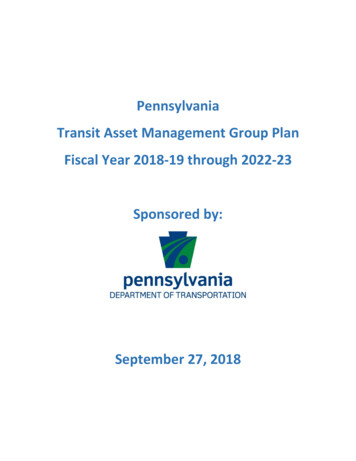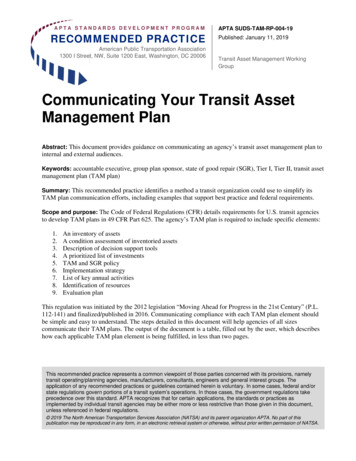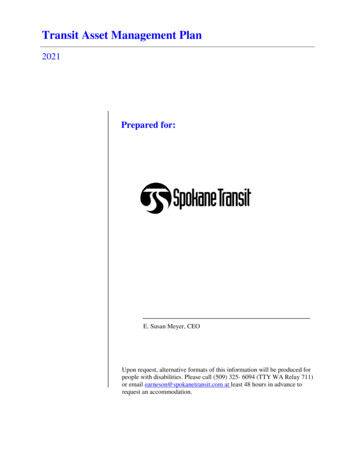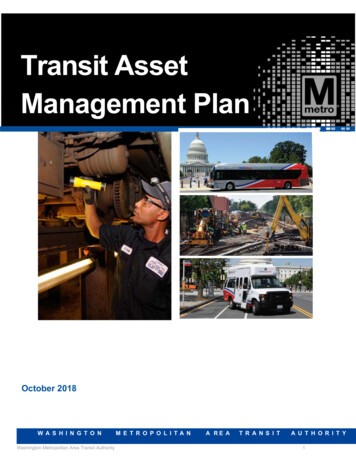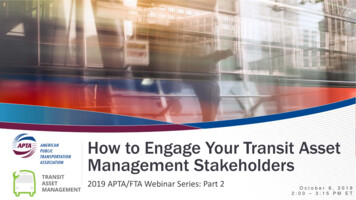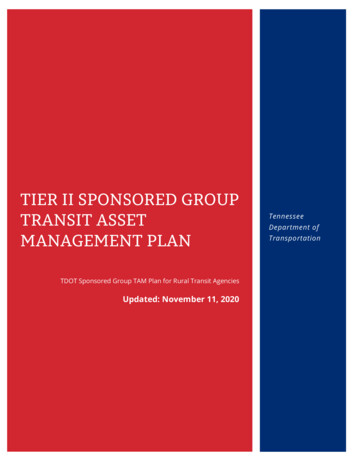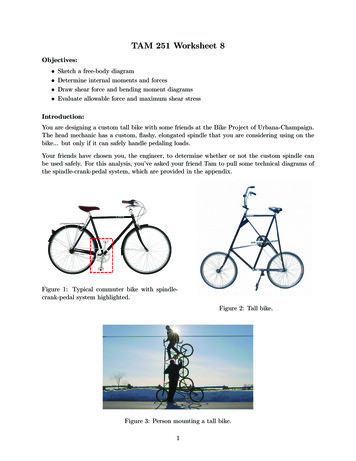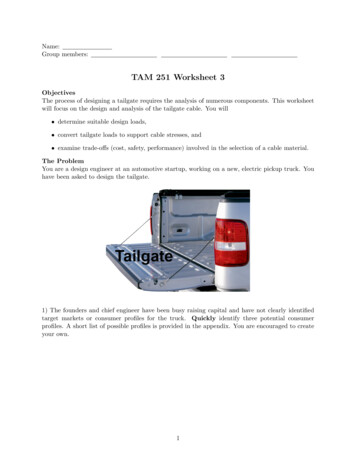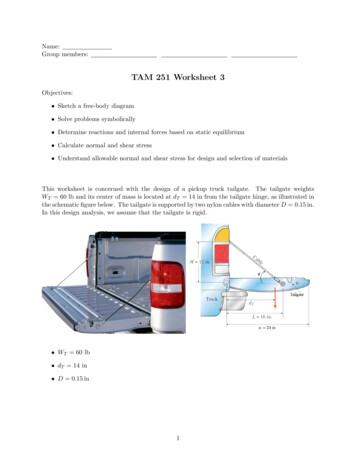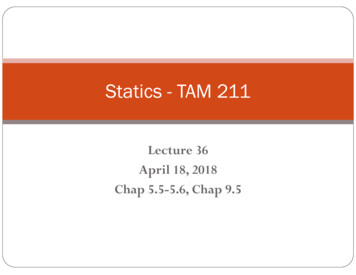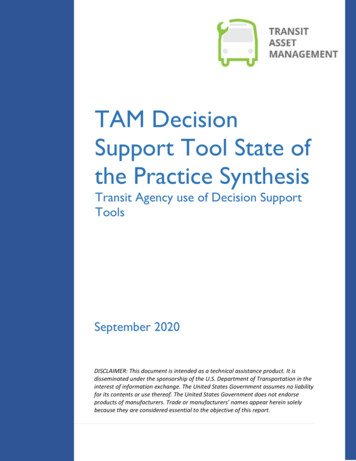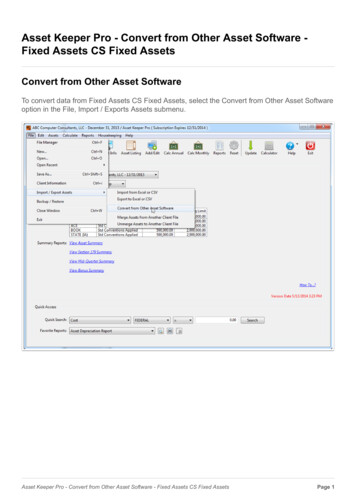
Transcription
Transit Asset Management (TAM) PlanState-sponsored Group PlanOctober 1, 2018
Table of contentsBackground . 1Asset management . 2KDOT Group Plan . 2Frequency . 3Outreach . 3Participants . 4Accountable Executive . 4Roles and responsibilities. 5Performance Measures . 6Useful Life Benchmarks . 6Targets (percentages) . 6Targets (TERM scores) . 7State of Good Repair. 8Timeline. 9Data to be reported in the Group Plan. 10Target setting . 10Why we develop targets . 11Data and analysis processes . 11Decision support tools . 11Prioritizing investments . 13Fiscal constraint . 13Approval of the Group Plan . 13Reporting to the National Transit Database (NTD) . 13Annual target setting . 14
Amending the Group Plan . 14Annual certification . 14Agency non-compliance . 15Appendix A: Group Plan targets and Useful Life Benchmarks (ULBs)Appendix B: Decision Support tool calculationsAppendix C: Facility scorecardsAppendix D: Inventory of 5311 vehiclesAppendix E: NTD-assigned numbers for all 5311 agenciesPublic outreach effortsThe TAM Plan, process, process updates, and final draft were all available for publicreview and comment. They were distributed via webinar, conference call, PowerPointslides, email distribution lists to our providers and the Federal Transit AdministrationRegion VII office, and the final draft placed on our website. No comments werereceived.
BackgroundIn 2012, MAP-21 mandated FTA to develop a rule establishing a strategic andsystematic process of operating, maintaining, and improving public capital assetseffectively through their entire life cycle. The TAM Final Rule 49 USC 625 becameeffective Oct. 1, 2016 and established four performance measures. The performancemanagement requirements outlined in 49 USC 625 Subpart D are a minimum standardfor transit operators. In accordance with 49 U.S.C. § 5335, agencies are required tocalculate and report new data elements to the National Transit Database (NTD).New and updated regulations require transit agencies reporting to the NTD to includecondition information on assets reported to the database. To satisfy this newrequirement, the condition of each vehicle and facility supporting transit operations mustbe reported to the NTD.The TAM rule established performance measures to be reported to the NTD AssetInventory Module (AIM) at 49 CFR part 625. In addition to AIM reporting, the TAM rulerequires asset inventory and asset condition assessments at a level of detail sufficientto monitor and predict the performance of assets and to inform investment prioritizationin the TAM Plan. Facility condition assessments must be conducted by assessing thecondition of and assigning a rating for facility assets using FTA's Transit EconomicRequirements Model (TERM) scale.Information on facility conditions is intended to supplement other facility-relatedinformation entered in the NTD AIM.NOTE: The category of INFRASTRUCTURE is also a component of TAM planning, butdoes not apply to the State of Kansas, as we do not have any passenger rail inoperation in our state.NOTE: As there are no agencies in the KDOT Group Plan that exceed the thresholds ofTier II providers, the Group Plan only covers the reporting required for Tier II agencies.Tier II agencies include: subrecipients of 5311 fundsAmerican Indian Tribesless than 100 vehicles in fixed route modesless than 100 vehicles in one non-fixed route modePage 1
Asset managementFor many organizations, asset management is a newway of planning for the future of their business.Successful asset management tracks an assetthroughout its entire useful life until replacement ordisposal. KDOT hopes to incorporate asset managementinto the existing project selection matrix to allocateavailable funding to plans, projects, and purchases in amanner that both prioritizes the needs of our state as wellas ensures we are being good stewards of taxpayerdollars.At its core, transit asset management (TAM) is a datadriven process. We will be using both existing and newdatasets to track spending against many indicators, suchas asset age, condition, and useful life. The resultinganalysis will not only help us better manage our Program,but also build a data source that can assist planningagencies and local governments in making the bestpossible decisions in support of policies and fundingrelated to public transportation.KDOT Group PlanThe majority of agencies in Kansas receiving 5307, 5310,and/or 5311 funds have accepted KDOT’s targets assubmitted to FTA and decided to participate in the KDOTGroup Plan (Group Plan). The Group Plan is designed toreduce the planning and reporting burden on smallertransit agencies from having to develop individual plansand report to FTA’s National Transit Database (NTD) ontheir own. They have agreed to be covered under theGroup Plan, which will be analyzed in aggregate.There are two transit agencies that have written their ownplans (Kansas City Area Transit Agency and WichitaTransit). KDOT will reference their targets and data inthis document, however those respective agencies arewholly responsible to FTA in submitting their TAM dataand analysis to FTA via the National Transit DatabaseFOUR REQUIREDELEMENTS OF ATAM PLANAsset inventory: A register,repository,orcomprehensive list of anagency’s assets and specificinformation about thoseassets.ConditionAssessment:The process of assessinganddocumentingthecondition of residual life ofan asset.Decision Support Tools:An analytic process ormethodology to: (1) helpprioritizeprojectsandmaintain the state of goodrepair of capital assetswithin a public transportationsystem, based on availablecondition data and objectivecriteria; or, (2) assessfinancial needs for assetinvestments over time.Investment Prioritization:A transit provider’s rankingofcapitalprojectsorprograms to achieve ormaintain a state of goodrepair based on financialresources from all sourcesthat a transit providerreasonably anticipates willbe available over the TAMplan horizon.(source: FTA)Page 2
(NTD) and updating their targets and documents as prescribed by FTA.Additionally, each MPO in Kansas was sent the State of Good Repair chart and UsefulLife Benchmarks that KDOT adopted on January 1, 2017. Most MPOs acceptedKDOT’s SGRs and ULBs as presented. Two MPOs (Mid America Regional Council inthe Kansas City metro and Wichita Area Metropolitan Planning Organization in theWichita metro) chose to set their own SGRs and ULBs. Those MPOs are responsiblefor tracking their annual data, analyzing the results, and reporting those results to KDOTand the transit providers in their respective planning areas.Please note that Section 5310-funded agencies that do not also provide general publictransportation are not required, but are encouraged, to participate in TAM Plan efforts atthis time. For example, senior centers that receive 5310 funding or other client-basedservices are not subject to the TAM rule at this time. Participation requirements maychange in future years, and the Group Plan will be updated accordingly.FrequencyKDOT, along with any agency that chooses not to use the KDOT Group Plan, mustreport data annually and review the document, data, implementation strategies, budget,goals, and outcomes at least every 4 years. Revisions to TAM Plans can be donebetween required updates but must be accepted by FTA and incorporated into the TIP(if in an MPO area) or STIP (all other areas) before they become official.OutreachAn invitation to participate in the Group Plan was extended to all public transit andparatransit agencies as well as all of the MPOs in Kansas. A conferencecall/PowerPoint presentation was given at KDOT headquarters in March, 2017 outliningthe components of the TAM Plan, the process that would be followed, and the offer forall agencies in the TAM Plan process to participate under the Group Plan. KDOT hasengaged the public transit providers in Kansas via email, conference call, presentations,and review & comment periods as the Group Plan developed. Consensus wasdeveloped as to the general philosophy, policies, and roles and responsibilities that bothKDOT and each transit agency would follow.While all agencies agreed with the overarching intent of the TAM Plan process, thoseagencies that opted-out of the Group Plan will be responsible for their own respectiveindividual plans, target setting, and reporting requirements.Page 3
ParticipantsKDOT, as Group Plan Sponsor, will be responsible for reporting data and target updatesannually to the NTD as well as updating the Group Plan at least every four years.KDOT has offered every transit agency in Kansas to participate in the Group Plan;almost all have agreed.Data will be collected in a variety of formats, including NTD data, Black Cat user profilesand inventories, surveys with Group Plan participants, and in-person or webinar-formatdiscussions.The Group Plan Sponsor is responsible for deciding on, developing, and communicatingthe following components of the TAM Plan process: Eligibility for participation in the Group PlanPlans, timeline, and deadlines for TAM Plan developmentData needs and formats from agenciesProcedures for having policy discussionsPlans for setting targets and having policy discussionsThresholds for amending the TAM PlanThresholds for a TAM Plan updateCoordination with planning organizations, andExpectations for the process of opting outPublic transportation providers assist the elderly, individuals with disabilities, and thegeneral public in getting to all the places they live, work, learn, play, and heal.Participants choosing to opt-out of Group TAM Plans must notify KDOT no later than 12months prior to the next TAM plan due date.Accountable ExecutiveEach transit provider must designate an Accountable Executive responsible forapproving the Group Plan. This person often serves as the agency’s chief executive.Each agency identifies their Accountable Executive, which is not required to be a newposition. In some cases, the Accountable Executive may be the same individual thatcertifies the NTD report.While the Accountable Executive is ultimately responsible for the agency’s participationin the Group Plan, other staff should be involved in the day-to-day development andimplementation of the Group Plan. In some agencies, one staff person may beresponsible for coordinating all aspects of TAM planning with KDOT. In other agencies,staff from throughout the organization will provide the technical expertise. In smallPage 4
agencies where resources are limited, the Accountable Executive may also assume theday-to-day responsibilities.Roles and responsibilitiesThe following chart outlines the roles and responsibilities for KDOT and Group Planparticipants. Continual collaboration throughout the development of the Group Plan willhelp ensure that all participants are on board with the targets, goals, and objectives.ElementOverarchingKDOTWrite Group PlanAsset inventoryCoordinate consolidationDevelop/modify databaseDefine data collection elementsand formatsDefine data collectionmethodology and scheduleManage dataSubmit final data to NTDShare guiding policies includingweighting or ranking prioritiesDevelop toolsAnalyze and interpret dataGather additional dataPrioritize projects (iterativesteps)Generate ranked list of projectsConditionAssessmentDecisionSupport ToolsInvestmentPrioritizationCoordinate target setting withthe participating transitproviders’ AccountableExecutives, to the extentpracticableReport targets to NTDAnnualDevelop the Annual NarrativeNarrative Report ReportSubmit Narrative to NTDNTD AssetFor those participants that doInventorynot report independently, reportbasic TAM information,including: agency profile; assetinventory; and facility conditionassessmentGroup Plan participantsSupport Group PlanAccountable Executive approvesplanCollect asset dataSubmit data in format requiredon scheduleSupport/conduct conditionassessmentsCommunicate goals and needsProvide information to supporttoolShare information on all fundingsources with KDOTShare existing CapitalInvestment PlansCoordinate with KDOTAnnual TargetSettingFor those participants that reportindependently to NTD areresponsible for reporting basicTAM information, including:agency profile, asset inventory,and facility condition assessmentPage 5
Performance MeasuresKDOT has established the following core performance measures for use in the analysisof data collected to inform the TAM Plan: Rolling Stock: The percentage of revenue vehicles (by type) that exceed theuseful life benchmark (ULB).Equipment: The percentage of non-revenue service vehicles (by type) thatexceed the ULB.Facilities: The percentage of facilities (by group) that are rated less than 3.0 onthe Transit Economic Requirements Model (TERM) Scale.As part of the annual report, an agency must submit overall facility condition ratings foreach facility in its asset inventory for which it has direct capital responsibility. However,this does not imply that condition data must be collected annually. FTA requires thatfacility condition data be fully updated every four years, at a minimum, so KDOT will besubmitting facility data for all facilities covered in the Group Plan once every four years.Only facilities that are actively used to support revenue service are required to havetheir condition assessed. As such, facilities under construction are exempt fromcondition assessment requirements.Additionally, KDOT will consider the following supporting Performance Measures whendeveloping the ranked investment priorities matrix: Age of individual revenue vehicles, by agencyMileage of individual revenue vehicles, by agencyAvailability of local match dollars for replacement vehicles, by agencyAsset replacement plans and policies, by agencyUseful Life BenchmarksAppendix B illustrates the Useful Life Benchmarks being used for this Group Plan.KDOT considered the standardized FTA ULBs when developing our own ULBs. Webelieve that our ULBs better reflect the fleet and facilities of operation in Kansas as wellas taking into consideration the geography and topology our state enjoys.We have also listed the ULBs and target percentages of agencies that chose not toparticipate in our Group Plan, for reference.Targets (percentages)As Group Sponsor, KDOT (in coordination with most of the transit service providers inPage 6
the rural and small urban areas and the MPOs in the Topeka, Lawrence, Manhattan, KSand St. Joseph, MO regions) has established a set of Targets for the Group Plan. Alarger scale version of this chart, along with the targets set by agencies that chose tosubmit independent TAM Plans, can be found in Appendix A.TAM Plan targets set as of 01.01.17CategoryClassExampleAbbreviationBased onRolling Stock (revenue vehicles)Over-the-road BusFull-sized BusCutaway BusVanMinivanAutomobileFTA Useful LifeMotorcoachGilligFord Cut-awayFord TransitDodge CaravanFord TaurusBRBUCUVNMVAOAgeAgeAgeAgeAgeAgeEquipment (non-revenue vehicles)VanMinivanSUVAutomobileCutaway BusVNMVSVAOCUAgeAgeAgeAgeAgeFacilities nger12 years / 500K miles10 years / 350K miles4 years / 100K miles4 years / 100K miles4 years / 100K miles4 years / 100K milesFTA Useful LifeFord TransitDodge CaravanFord ExplorerFord TaurusFord Cut-away4 years / 100K miles4 years / 100K miles4 years / 100K miles4 years / 100K miles4 years / 100K milesFTA Useful LifeAgency headquartersRepair garage 500 spacesIndoor transit hub nConditionConditionKDOT Group Plan(includes MPOs in Flint Hills, Topeka, Lawrence, andSt. Joe)FTA40 years40 years40 years40 yearsULBULBKDOT Replacementthresholdx% of fleet that isolder than the ULB(Staet of GoodRepair - SGR)14141088814141088814 years / 750K miles12 years / 500K miles5 years / 100K miles5 years / 100K miles5 years / 100K miles--25%25%25%25%25%--ULBULBKDOT Replacementthreshold8888108888105 years / 100K miles5 years / 100K miles5 years / 100K miles5 years / 100K miles--TERMULB(TERM)KDOT Replacementthresholdx% of facilities thatscores 3.0 on theTERM %25%x% of fleet that isolder than the ULB(Staet of GoodRepair - SGR)75%75%75%75%--Targets for each asset class have been set and should be read as “not more than x% ofour vehicles will have passed the KDOT-developed ULB.” These values are our targetsfor fleet maintenance and upkeep. These targets may be changed to better align withthe needs of our public transportation system in future years’ reporting.Targets (TERM scores)Similarly, the facility targets are based on FTA’s TERM scale of asset condition, whichis an index of inspections of each system included in the building. The TERM scaleruns from 5 (excellent) to 1 (poor). WE contracted the task with external consultantsfrom TranSystems and Groundswell Consulting to ensure a fair and impartial inspection.Scores for each category will be combined and averaged, and the final result rounded tothe nearest whole number. Please refer to the table below for descriptions of thescores; each facility’s completed scorecard can be found in Appendix C.RatingConditionDescription5ExcellentNo visible defects, new or near new condition, may still bePage 7
under warranty if app
TAM PLAN Asset management For many organizations, asset management is a new way of planning for the future of their business. Successful asset management tracks an asset throughout its entire useful life until replacement or disposal. KDOT hopes to incorporate asset management
